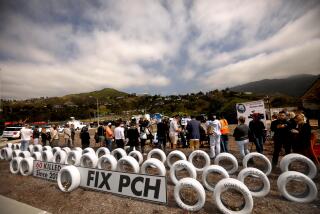Focus on the Other Costs of Drunk Driving
- Share via
By now, no one should be surprised to see television spots on a holiday weekend cautioning people to refrain from drinking and driving.
But a federally funded advertisement airing through the end of this week doesn’t say a word about safety or death tolls. It doesn’t show a single ambulance and doesn’t say, “Friends Don’t Let Friends Drive Drunk,” the famous slogan of a long-running public service campaign against impaired driving.
Instead, the commercial, which began airing shortly before the Fourth of July weekend and will continue through Sunday, shows drivers getting arrested -- over and over again: A young couple look behind them to see the red lights of a police car; a man reacts as he approaches a sobriety checkpoint; a man is ordered out of his car and handcuffed.
The new, tough message in the ads is the result of a hard-learned lesson from years of failed campaigns: Drivers, particularly young ones, generally don’t respond to warnings that they will be harmed by driving drunk or not using seat belts -- or by other types of dangerous driving. But they do respond when threatened with a night in jail or the loss of their licenses.
“With this campaign we are putting violators on notice that if they drink and drive, they face the prospect of being caught, arrested and prosecuted,” U.S. Transportation Secretary Norman Mineta said at a news conference kicking off the campaign.
In what the National Highway Traffic Safety Administration says is a first for the federal government, Congress appropriated $11 million for commercial media buys for the ads. Half the money was used to buy time on national networks and programs. But the other half was reserved for additional air time for spots in 13 states, including California, where drunk driving is particularly prevalent.
Using paid advertising instead of public service spots allows the commercial to have a broader range of content and gives the government more say in when and where it runs, said Jeff Michael, who directs impaired driver programs for the National Highway Traffic Safety Administration.
In 2001, the last year for which data is available, about 18,000 people died in the United States in alcohol-related auto accidents. A third of those accidents involved drivers between the ages of 21 and 24.
Because drinking is on the rise among young people, and because drivers 21 to 24 are the most likely to be involved in fatal drunk driving crashes, the government has purchased time for the new spot during programs that appeal to young people.
The ad appears on both cable and broadcast shows, including Fox’s “Anything for Love,” NBC’s “Dog Eat Dog,” and ESPN’s “Sportscenter.” It is also airing in Spanish, on programs such as Univision’s “Futbol” and Telemundo’s “Factor Miedo” (“Fear Factor”).
The problem with past efforts, which tended to focus on the dangers of drunk driving, is that most people who drink and drive don’t believe they’ll cause accidents, said Stuart Fischoff, professor emeritus of media and psychology at Cal State L.A.
“People who drive drunk don’t really believe they’re drunk ... and they don’t think they’re jeopardizing other people,” he said. But “if you tell them it’s going to cost them money and they’re going to go to jail,” Fischoff said, they pay attention.
Federal safety experts believe that a similar program in Tennessee reduced alcohol-related crashes by 20%, and a seat belt campaign with the slogan “Click It or Ticket” was more successful than previous attempts to cajole people into buckling up.
For this campaign, called “You Drink, You Drive, You Lose,” officials chose the period around the Fourth of July because it is traditionally the deadliest time of year for drunk driving accidents. This year, the American Automobile Assn. expected 37.4 million people to be on the nation’s highways over the three-day Independence Day weekend -- 5.4 million of them from California.
“What we’ve found both with safety belt use and with impaired driving is you need a combination of messages to change behavior,” said Michael, of the National Highway Traffic Safety Administration.
“Education about why safety belts work or reminding people that impaired driving does lead to crashes ... is not a very powerful behavior-change strategy,” he said. “You need to use that in conjunction with a strong law enforcement message. The two together are quite powerful.”
To that end, the traffic safety agency has coordinated a nationwide police crackdown on drunk driving, which will also continue through Sunday, to accompany the advertising push.
In Los Angeles, where the LAPD has received a $400,000 grant for drunk driving enforcement, the effort will continue through the end of the year, with officers on overtime putting in 3,500 extra hours patrolling for motorists who are under the influence of drugs or alcohol.
“We are going to arrest hundreds and hundreds of extra DUI drivers over the next several months,” said Capt. Greg Meyer, commanding officer of the LAPD’s San Fernando Valley Traffic Division.
*
If you have a question, gripe or story idea about driving in Southern California write to Behind the Wheel c/o Los Angeles Times, 202 W. 1st St., Los Angeles, CA 90012, or send an e-mail to behindthewheel@latimes.com.
More to Read
Sign up for Essential California
The most important California stories and recommendations in your inbox every morning.
You may occasionally receive promotional content from the Los Angeles Times.













